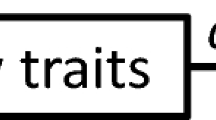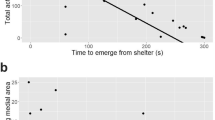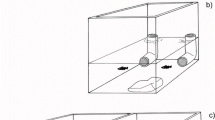Abstract
Conspecifics vary consistently in their behavioural responses towards environment stimuli such as exposure to novel objects; ethologists often refer to this variability as animal personality. The neurological mechanisms underlying animal personality traits remain largely unknown, but linking the individual variation in emotional expression to brain structural and neurochemical factors is attracting renewed interest. While considerable research has focused on hormonal and neurotransmitter effects on behavioural responses, less is known about how individual variation in the number of specific neuron populations contributes to individual variation in behaviour. The basolateral amygdala (BLA) and the central nuclei of the amygdala (CeA) mediate emotional processing by regulating behavioural responses of animals in a potentially threatening situation. As such, these structures are good candidates for evaluating the relationship between neuronal populations and behavioural traits. We now show that individual American mink (Neovison vison) reacting more boldly towards novelty have more neurons in the BLA than do their more timid conspecifics, suggesting that a developmental pattern of the number of amygdala neurons can influence behavioural traits of an adult animal. Furthermore, post hoc correlations revealed that individuals performing with higher arousal, as reflected by their frequency of startle behaviour, have more CeA neurons. Our results support a direct link between the number of neurons in amygdala regions and aspects of animal personality.






Similar content being viewed by others
References
Amaral DG (2003) The amygdala, social behavior, and danger detection. Ann N Y Acad Sci 1000:337–347
Aron EN, Aron A, Jagiellowicz J (2012) Sensory processing sensitivity: a review in the light of the evolution of biological responsivity. Pers Soc Psychol Rev 16(3):262–282
Bear MF, Connors BW, Paradiso MA (2007) Neuroscience: exploring the brain. 3rd edn. Lippincott Williams & Wilkins, Philadelphia
Bergmüller R, Taborsky M (2007) Adaptive behavioural syndromes due to strategic niche specialization. BMC Ecol 7:12
Boissy A (1995) Fear and fearfulness in animals. Q Rev Biol 70:165–191
Briggs SR, Cheek JM (1986) The role of factor analysis in the development and evaluation of personality scales. J Pers 54(1):106–148
Buss DM (2009) The great struggles of life: Darwin and the emergence of evolutionary psychology. Am Psychol 64:140–148
Calcagnoli F et al (2014) Local oxytocin expression and oxytocin receptor binding in the male rat brain is associated with aggressiveness. Behav Brain Res 15:315–322
Cardinal RN, Parkinson JA, Hall J, Everitt BJ (2003) The contribution of the amygdala, nucleus accumbens, and prefrontal cortex to emotion and motivated behavior. Int Congr Ser 1250:347–370
Chareyron LJ, Lavenex PB, Amaral DG, Lavenex P (2011) Stereological analysis of the rat and monkey Amygdala. J Comp Neurol 519:3218–3239
Coppens MC, de Boer SF, Koolhaas JM (2010) Coping styles and behavioural flexibility: towards underlying mechanisms. Philos Trans R Soc B Biol Sci 365:4021–4028
Dall SRX (2004) Behavioural biology: fortune favours bold and shy personalities. Curr Biol 14(12):470–472
Darwin C (1872/1965) The expression of the emotions in man and animals. University of Chicago Press, Chicago
DiStefano C, Zhu M, Mîndrilǎ D (2009) Understanding and using factor scores: considerations for the applied researcher. Pract Assess Res Eval 14(20)
Gardini S, Cloninger CR, Venneri A (2009) Individual differences in personality traits reflect structural variance in specific brain regions. Brain Res Bull 79:265–270
Grillon C, Baas J (2003) A review of the modulation of the startle reflex by affective states and its application in psychiatry. Clin Neurophysiol 114:1557–1579
Gundersen HJG, Jensen EBV, Kieu K, Nielsen J (1999) The efficiency of systematic sampling in stereology—reconsidered. J Microsc 193:199–211
Hartley CA, Fischl B, Phelps EA (2011) Brain structure correlates of individual differences in the acquisition and inhibition of conditioned fear. Cereb Cortex 21:1954–1962
Hebb DO (1946) Emotion in man and animal: an analysis of the intuitive processes of recognition. Psychol Rev 53:88–106
Hershberger SL (2005) Factor scores. In: Everitt BS, Howell DC (eds) Encyclopedia of statistics in behavioral science. Wiley, New York, pp 636–644
Hill SY, Tessner K, Wang S, Carter H, McDermott M (2010) Temperament at 5 years of age predicts amygdala and orbitofrontal volume in the right hemisphere in adolescence. Psychiatry Res 182(1):14–21
Iidaka T, Matsumoto A, Ozaki N, Suzuki T, Iwata N, Yamamoto Y, Okada T, Sadato N (2006) Volume of left amygdala subregion predicted temperamental trait of harm avoidance female young subjects. A voxel-based morphometry study. Brain Res 1125(1):85–93
Jacobs C, Van Den Broeck W, Simoens P (2006) Increased volume and neuronal number of the basolateral nuclear group of the amygdaloid body in aggressive dogs. Behav Brain Res 170:119–125
Jagalska-Majewska H, Wójcik S, Dziewiatkowski J, Luczyńska A, Kurlapska R, Morys J (2003) Postnatal development of the nasolateral complex of rabbit amygdala: a stereological and histochemical study. J Anat 203(5):513–521
Koolhaas JM, Korte SM, De Boer SF, Van Der Vegt BJ, Van Reenen CG, Hopster H, De Jong IC, Ruis MA, Blokhuis HJ (1999) Coping styles in animals: current status in behavior and stress-physiology. Neurosci Biobehav Rev 23(7):925–35
Kosmal A, Nitecka L (1977) Cytoarchitecture and acetylcholinesterase activity of the amygdaloid nuclei in the dog. Acta Neuro Biol Exp 37:363–374
Krettek JE, Price JL (1978) A description of the amygdaloid complex in the rat and cat with observations on intra-amygdaloid axonal connections. J Comp Neurol 178:255–280
LeDoux JE (2000) Emotion circuits in the brain. Annu Rev Neurosci 23:155–184
LeDoux JE (2012) Rethinking the emotional brain. Neuron 73(4):653–676
Lind NM et al (2005) Behavioral response to novelty correlates with dopamine receptor availability in striatum of Göttingen minipigs. Behav Brain Res 164(2):172–177
Mai JK, Voss T, Paxinos G (2007) Atlas of the human brain. http://www.thehumanbrain.info
Matsunaga M (2015) How to factor-analyze your data right: do’s, don’ts, and how-to’s. Int J Physchol Res 3(1):97–110
Michalski RL, Shackelford TK (2010) Evolutionary personality psychology: reconciling human nature and individual differences. Personal Individ Differ 48:509–516
Morán MA, Gómez-Ramos P (1992) Cholinesterase histochemistry in the human brain: effect of various fixation and storage conditions. J Neurosci Methods 43:49–54
Morey RA et al (2012) Amygdala volume changes in posttraumatic stress disorder in a large case–controlled veterans group. Arch Gen Psychiatry 69:1169–1178
Noer CL, Needham EK, Wiese A-S, Dabelsteen T (2015) Context matters: Multiple novelty tests reveal different aspects of shyness–boldness in farmed American Mink (Neovison vison). PLoS One 10(6) https://doi.org/10.1371/journal.pone.0130474
Noer CL, Needham EK, Wiese A-S, Balsby TJS, Dabelsteen T (2016) Personality matters: consistency of inter-individual variation in shyness–boldness across non-breeding and pre-breeding season despite a fall in general shyness levels in farmed American mink (Neovison vison). Appl Anim Behav Sci 181:191–199
Pakkenberg B, Gundersen HJG (1995) Solutions to old problems in the quantitation of the central nervous system. J Neurol Sci1 29:65–67
Paul ES, Harding EJ, Mendl M (2005) Measuring emotional processes in animals: the utility of a cognitive approach. Neurosci Biobehav Rev 29:469–491
Reále D, Reader SM, Sol D, McDougall PT, Dingemanse NJ (2007) Integrating animal temperament within ecology and evolution. Biol Rev 82:291–318
Ross HE, Young LJ (2009) Oxytocin and the neural mechanisms regulating social cognition and affiliative behavior. Front Neuroendocrinol 30:534–547
Rubinow MJ, Juraska JM (2009) Neuron and glia numbers in the basolateral nucleus of the amygdala from preweaning through old age in male and female rats: a stereological study. J Comp Neurol 512:717–725
Sah P, Faber ESL, Lopez De Armentia M, Power J (2003) The amygdaloid complex: anatomy and physiology. Physiol Rev 83:803–834
Shumann CM, Amaral DG (2006) Stereological analysis of amygdala neuron number in autism. J Neurosci 26:7674–7679
Sih A, Bell A, Johnson JC (2004) Behavioural syndromes: an ecological and evolutionary overview. Trends Ecol Evol 19:372–378
Svendsen CN, Bird ED (1985) Acetylcholinesterase staining of the human amygdala. Neurosci Lett 54(2–3):313–318
Toth M, Fuzesi T, Halasz J, Tulogdi A, Haller J (2010) Neural inputs of the hypothalamic “aggression area” in the rat. Behav Brain Res 215:7–20
Uher J (2011) Individual behavioral phenotypes: an integrative meta-theoretical framework. Why “behavioral syndromes” are not analogs of “personality”. Dev Psychobiol 53(6):521–548
Uylings HB, Jacobsen AM, Zilles K, Amunts K (2006) Left–right asymmetry in volume and number of neurons in adult Broca’s area. Cortex 42:652–658
Walløe S, Eriksen N, Dabelsteen T, Pakkenberg B (2010) A neurological comparative study of the Harp Seal (Pagophilus groenlandicus) and Harbor Porpoise (Phocoena phocoena). Brain Anat Rec 293:2129–2135
Ward BC, Nordeen EJ, Nordeen KW (1998) Individual variation in neuron number predicts differences in the propensity for avian vocal imitation. Proc Natl Acad Sci USA 95:1277–1282
West MJ, Slomianka L, Gundersen HJ (1991) Unbiased stereological estimation of the total number of neurons in the subdivisions of the rat hippocampus using the optical fractionator. Anat Rec 231(4):482–497
Wilson DS, Clark AB, Coleman K, Dearstyne T (1994) Shyness and boldness in humans and other animals. Trends Ecol Evol 9:442–446
Wolf M, van Doorn GS, Weissing FJ (2008) Evolutionary emergence of responsive and unresponsive personalities. PNAS 105(41):15825–15830
Zilles K, Amunts K (2013) Individual variability is not noise. Trends Cogn Sci 17(4):153–155
Acknowledgements
We thank Inglewood Biomedical Editing for expert assistance in preparing the manuscript, and Susanne Sørensen at the Research laboratory for Stereology and Neuroscience for expert technical assistance on histological handling of the tissue.
Author information
Authors and Affiliations
Corresponding author
Ethics declarations
Conflict of interest
The authors declare that they have no conflict of interest.
Research involving animals
All procedures performed in studies involving animals were in accordance with the ethical standards of the institution or practice at which the studies were conducted.
Informed consent
This article does not contain any studies with human participants performed by any of the authors.
Electronic supplementary material
Below is the link to the electronic supplementary material.
Rights and permissions
About this article
Cite this article
Wiese, AS., Needham, E.K., Noer, C.L. et al. The number of neurons in specific amygdala regions is associated with boldness in mink: a study in animal personality. Brain Struct Funct 223, 1989–1998 (2018). https://doi.org/10.1007/s00429-018-1606-4
Received:
Accepted:
Published:
Issue Date:
DOI: https://doi.org/10.1007/s00429-018-1606-4




